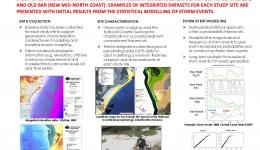Lead end user
This project developed better predictions and forecasts for extreme water levels arising from storm surges, surface waves, continental shelf waves, meteorological tsunamis, mean sea level rise and the transition from tropical to extra-tropical cyclones.
Research team:
The fundamental processes that cause erosion during storms are generally well understood and management strategies are available. However, the response of beaches to successive storms (storm clusters), such as those that damaged Australia’s east coast in 1974, is not well understood or managed, with the response of any given beach depending on its physical characteristics. Because of this, the likely effectiveness of a given management strategy may not be clear, such as beach nourishment (a remedial process where sand is added to a beach to restore its shape). This project developed a methodology and demonstrated it through two case study sites, which had different oceanographic and geological settings. The methodology combined expertise in statistical modelling, hydrodynamics, coastal geology, hazard mapping and impact analysis. The project integrated these approaches to develop tools, information and methods that can be used by others nationally.
Research team:
18 Aug 2015
The aim of the project is to develop a new method to quantify the potential hazard associated with...
Resources credited
| Type | Released | Title | Download | Key Topics |
|---|---|---|---|---|
| Presentation-Slideshow | 07 Jul 2017 | Water, water everywhere: living with flood and coastal threats |
|
flood, severe weather, storm surge |




